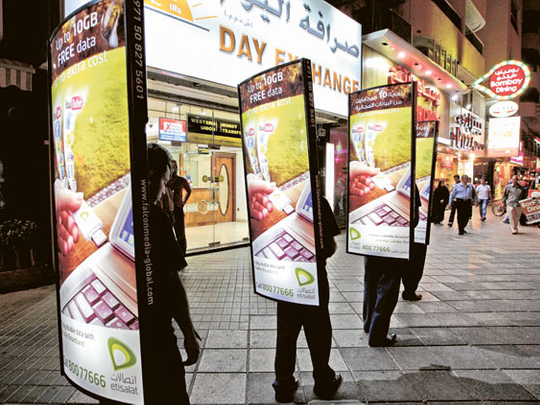
Dubai: The UAE reclaimed its standing as the Arab world's top advertising market for the first quarter of this year helped by its own fundamentals as well as Egypt's pre-occupation with the ouster of Hosni Mubarak. This could well be the pattern as advertisers exercise a "cautious optimism" about the industry's prospects for the full year.
With an overall spend of $349 million (Dh1.28 billion) in the first three months, the UAE is estimated to have accounted for 12 per cent of the overall Middle East ad spend during the first quarter. Egypt's first-quarter tally came to $166 million, according to data from Pan Arab Research Centre (Parc).
As for the wider region, while the waves of unrest were being played out on television screens, newspapers and radio, advertisers — and their agencies — were wary of placing high-profile ad campaigns on the very same media. Clearly, brand campaigns do not sit well alongside images of unrest on the streets.
"The political unrest being experienced in certain parts of the region impacted directly," said Shaharyar Umar of Pan Arab Research Centre, which tracks ad spend patterns based on official media rate cards.
"The buoyant regional ad spend market came to a standstill in the first quarter with a one per cent decline as spending in Egypt plummeted by 51 per cent, and Bahrain and Jordan were down 21 per cent each during the first quarter."
Overall spending in the pan-Arab media closed the first three months of this year with seven per cent growth compared to 42 per cent growth for the full year 2010.
In the UAE, the tone was decidedly bullish with an overall three per cent growth during the same period, helped by the middling to strong response by advertisers to the DSF 2011 and the recent cricket World Cup in the subcontinent.
Receptive mood
In addition, advertising related to key retail categories such as consumer goods and automobiles drove up spending patterns. The telecom space was another category to keep the media busy with its ads.
The same could be said of Saudi Arabia, where the advertising industry achieved 11 per cent growth during the first quarter.
According to the Nielsen Global AdView Pulse report — to which Parc contributed — the Middle East posted the highest growth of 26 per cent compared to other monitored blocs in 2010. Fast moving consumer goods spend in the Middle East increased by around 34 per cent last year.
At the regional level, it was clear multinational clients — many of them representing FMCG brands — were circumspect about sending out feel-good ad campaigns while the populace in some of the key markets — and Egypt notably — were far from being in a receptive mood. Worst hit in this regard were television commercials as multinationals have traditionally used this medium to showcase pan-regional campaigns.
In fact, it was quite noticeable that local brands were at the fore in terms of spending. "Local advertisers were on top in the first quarter of this year while multinationals were certainly less active," said Satish Mayya, who heads BPG Maxus, a media buying agency.
He remains an optimist that the situation could revert to a state of normalcy by the second half, with Egypt's political situation recording a measured improvement and the likes of Saudi Arabia benefiting from the high oil prices and what this will do to all layers of its economy.
But ad industry sources were not expecting a quick turnaround. In fact, they even expect a further deterioration in spending for the rest of the year.
"Many network agencies have downgraded the annual ad spend forecast for 2011; in many of the markets, advertisers are having a relook at the ad content and placement so that the regional sensitivity is not compromised," said Vijaya Kumar Appar of Dubai based Publilink.
Upturn: Radio back in limelight
All of the hype might have been garnered by digital media and what it could do, but no one can afford to write off radio's prospects as a viable advertising medium. On the contrary, things have never looked better for radio… at least in the Gulf.
For 2011, radio could record a robust double-digit growth in airing ads, which would be a continuation of the 10 per cent recorded last year. In the process, the successive upturns would reverse the decline in 2009, when it was down 5 per cent.
"Radio has grown by around 20 per cent during the first quarter in the UAE, and if you look at it in purely percentage growth terms, it's the star performer," said Satish Mayya of BPG Maxus.
Japanese brand owners shift focus
Look to the Japanese brands and their owners to make a strong pitch in the coming weeks to regain their visibility in the Middle East marketplace.
The devastating consequences of the tsunami and the earthquake have led to persistent doubts about whether Japanese made goods will face supply disruptions going forward. To allay these and reclaim the trust of buyers here, Japanese brand owners are reworking their campaign plans.
They will need to. "Over the past weeks, non-Japanese automobile brands have enhanced their media presence primarily in the print media," said Vijaya Kumar Appar of Publilink.
"Consumers have also started looking at Japanese products with some scepticism. To counter this, Japanese brands will need to increase their share of voice in the media."
For the many media platforms in the region, such decisions spell good business for themselves.
— M.N.












